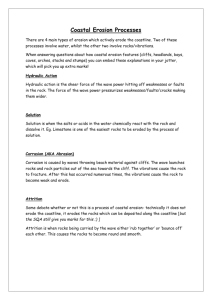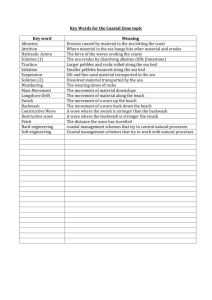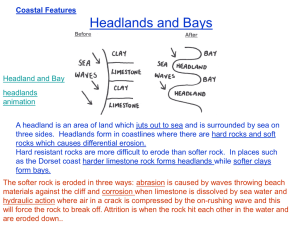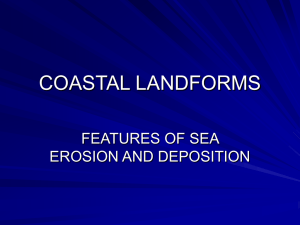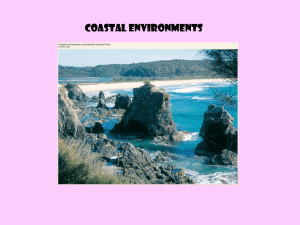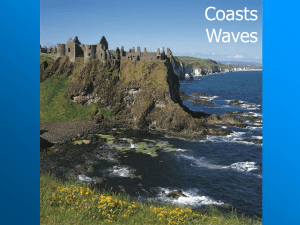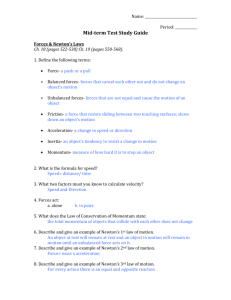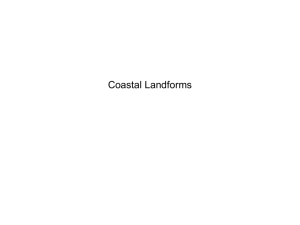Coasts
advertisement
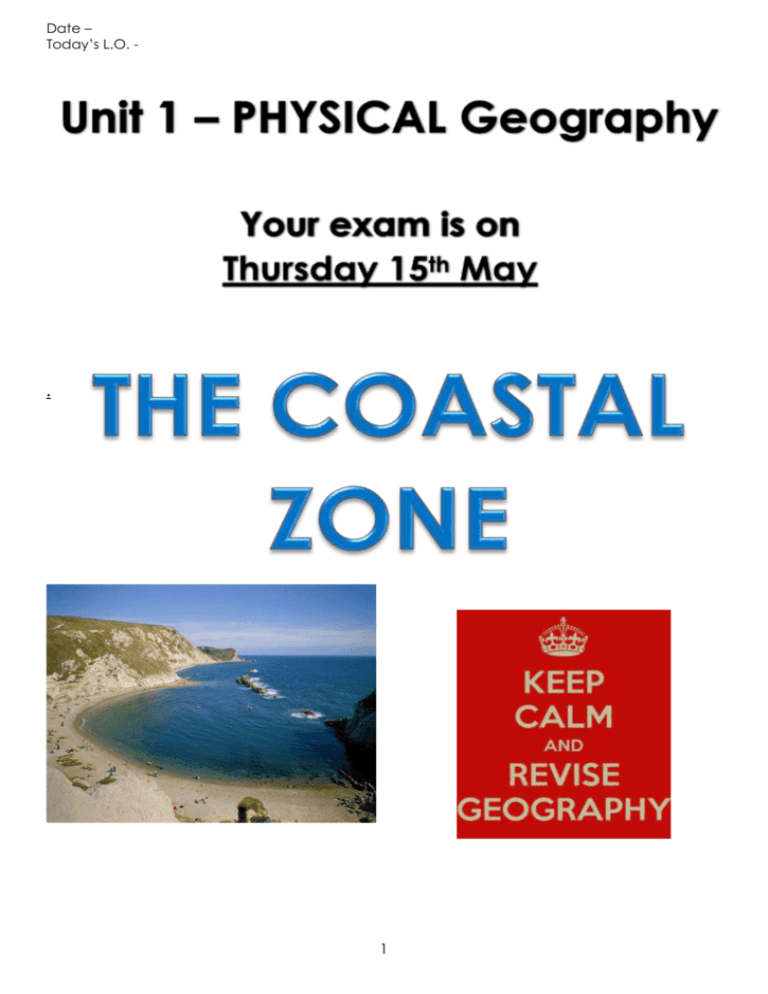
Date – Today’s L.O. - . 1 Date – Today’s L.O. - Teacher Feedback Date marked WWW/EBI/NTT Date acted on 2 Date – Today’s L.O. - How do waves shape our coastline? Complete the key words table below by putting the correct number next to the statement: N° Key word N° Definition I know it 1 Fetch The forward movement of a wave 2 Beach 3 Crest A wave that has a weak swash and a strong backwash. The backward movement of a wave 4 Swash The deposit of sand or shingle at the coast. 5 Backwash The distance of open water a wave has travelled 6 Constructive wave The top of the wave. 7 Destructive waves A wave that had a strong swash and a weak backwash How do waves form? Draw a diagram of waves approaching the coast and explain why they break. _______________________________________________________________________________________________ _______________________________________________________________________________________________ _______________________________________________________________________________________________ _______________________________________________________________________________________________ There are 2 types of waves that change our coastline: Constructive Destructive 3 Date – Today’s L.O. - Land processes that shape our coastline N° Key word 1 Biological weathering 2 Physical weathering 3 4 Chemical weathering Cliff 5 Rockfall 6 7 Landslide Mudflow 8 Rotational slip N° Definition This is the action of plant roots and burrowing animals weakening the rock A steep or vertical face of rock found at the coast Blocks of rock slide downhill Breaking up of rocks without any chemical changes Eg. Freeze-thaw Slump of saturated soil and weak rock along a curved surface. The collapse of a cliff as individual rocks Slightly acidic rainwater causes certain rock types to dissolve and become weak Saturated (wet) soil and weakened rock flow down the slope What is weathering? What is mass movement? Draw the 4 types of mass movement that happen on the coastline. Rockfall Landslide Mudflow Rotational slip 4 I know it Date – Today’s L.O. - Marine Processes that shape our coastlines N° Key word 1 Hydraulic Power 2 Abrasion 3 4 Attrition Solution (erosion) 5 Suspension 6 Traction 7 Saltation 8 Solution (transportation) 9 Deposition 10 Longshore Drift N° Definition The sandpapering effect of sediment on a rock face. Limestone and chalk (for example) being dissolved by the acid in the sea water. Particles carried within the water. Large pebbles that are rolled along the sea bed. The sheer power of waves hitting the coastline. Sediment that can no longer be carried is left along the coastline. Rock fragments knocking into each other causing them to become smaller and rounder. The transport of sediment along a stretch of coast when waves approach the beach at an angle. A ‘hopping’ or ‘bouncing’ motion or particles too heavy to be suspended. Dissolved chemicals moving in the water. In the space below draw the four types of transportation Draw a diagram to show Longshore Drift 5 I know it Date – Today’s L.O. - Erosional Landforms: N° Key word 1 Wave cut platform 2 Wave cut notch 3 Cave 4 Arch 5 Stack 6 Stump 7 8 Headland Bay N° Definition A small indentation cut into a cliff by coastal erosion at the level of high tide. A headland that has been partly broken through by the sea. A stack that has been eroded and is now smaller and shorter. A wide gently sloping rocky surface at the foot of a cliff A point of usually high land jutting out into the sea. A hollowed out feature at the base of an eroding cliff A broad coastal inlet often with a beach An isolated pinnacle of rock sticking out of the sea. Headlands and Bays Wavecut Platforms Headland Formation 6 I know it Date – Today’s L.O. - CASE STUDY: (Coastal erosion) Holderness Coast General Information about the area Causes of erosion in the area Social Effects Environmental Effects 7 Date – Today’s L.O. - Depositional Landforms: N° Key word N° Definition I know it 1 Spit A spit that has grown across a bay. 2 Salt marsh 3 Bar A finger of new land made of sand or shingle jutting out into the sea. Low-lying coastal wetland mostly extending between low and high tide. Beaches Spits Example Information: Hurst Castle, Hampshire Bars 8 Date – Today’s L.O. - How will rising sea levels affect the coastal zone? Cause of coastal flooding CASE STUDY: (Coastal Flooding) East Anglia Economic / social / environmental / political effects. 9 A/A* Remember: Place Specific Detail Date – Today’s L.O. - How can coastlines be managed? Shoreline Management Plans are: Hard Engineering is Name Description Cost Advantages Disadvantages Description Cost Advantages Disadvantages Sea Wall Groynes Rock Armour Soft Engineering is Name Beach nourishment Dune regeneration Marsh creation Managed Retreat 10 Date – Today’s L.O. - CASE STUDY: (Coastal Defence) - Holderness A/A* Remember: Place Specific Detail Strategies put in place at Holderness Successes Problems 11 Date – Today’s L.O. - What are Salt Marshes and why are they special? N° Key word 1 Pioneer Plant 2 Sediment 3 Vegetation succession N° Definition A sequence of vegetation species colonising an environment The first plant species to colonise an area that is well adapted to living in a harsh environment. Loose rock that has been eroded before being transportation and deposition. Formation of Saltmarshes Salt Marsh Vegetation Succession 12 I know it Date – Today’s L.O. - CASESTUDY: (Coastal Habitat) Studland Bay A/A* Remember: Place Specific Detail General information about the area Species in the area Human conflict Why they are found there What is being done? Is it sustainable? Why? 13 Date – Today’s L.O. - Notes 14 Date – Today’s L.O. - 15
